sensor FIAT ULYSSE 2007 2.G User Guide
[x] Cancel search | Manufacturer: FIAT, Model Year: 2007, Model line: ULYSSE, Model: FIAT ULYSSE 2007 2.GPages: 254, PDF Size: 3.42 MB
Page 120 of 254
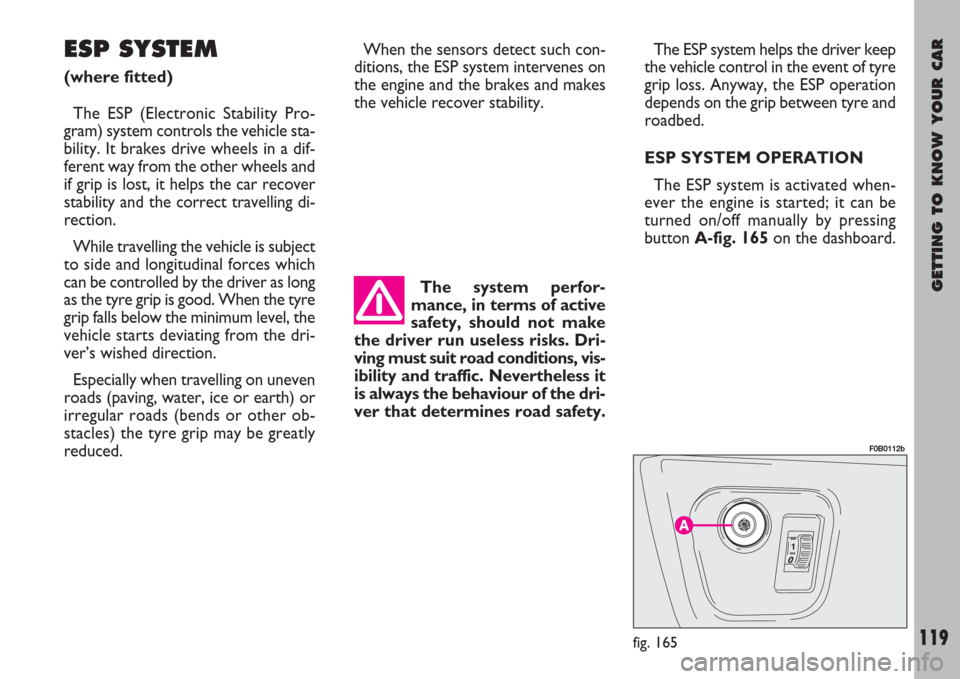
GETTING TO KNOW YOUR CAR
119
ESP SYSTEM
(where fitted)
The ESP (Electronic Stability Pro-
gram) system controls the vehicle sta-
bility. It brakes drive wheels in a dif-
ferent way from the other wheels and
if grip is lost, it helps the car recover
stability and the correct travelling di-
rection.
While travelling the vehicle is subject
to side and longitudinal forces which
can be controlled by the driver as long
as the tyre grip is good. When the tyre
grip falls below the minimum level, the
vehicle starts deviating from the dri-
ver’s wished direction.
Especially when travelling on uneven
roads (paving, water, ice or earth) or
irregular roads (bends or other ob-
stacles) the tyre grip may be greatly
reduced.When the sensors detect such con-
ditions, the ESP system intervenes on
the engine and the brakes and makes
the vehicle recover stability.
The system perfor-
mance, in terms of active
safety, should not make
the driver run useless risks. Dri-
ving must suit road conditions, vis-
ibility and traffic. Nevertheless it
is always the behaviour of the dri-
ver that determines road safety.
The ESP system helps the driver keep
the vehicle control in the event of tyre
grip loss. Anyway, the ESP operation
depends on the grip between tyre and
roadbed.
ESP SYSTEM OPERATION
The ESP system is activated when-
ever the engine is started; it can be
turned on/off manually by pressing
button A-fig. 165on the dashboard.
fig. 165
F0B0112b
Page 121 of 254
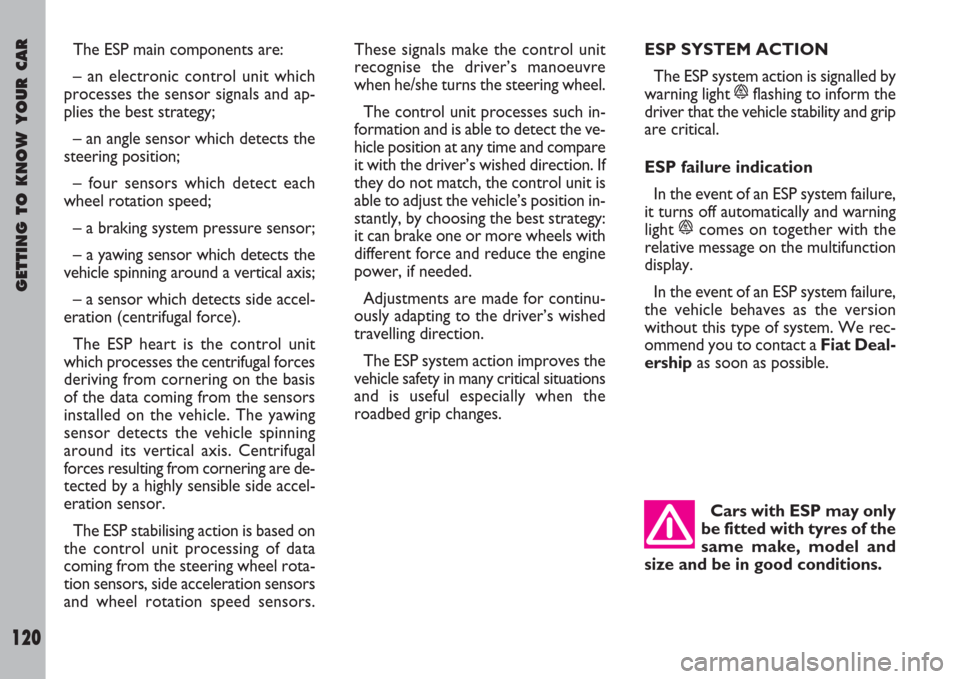
Cars with ESP may only
be fitted with tyres of the
same make, model and
size and be in good conditions.
GETTING TO KNOW YOUR CAR
120
ESP SYSTEM ACTION
The ESP system action is signalled by
warning light
ñflashing to inform the
driver that the vehicle stability and grip
are critical.
ESP failure indication
In the event of an ESP system failure,
it turns off automatically and warning
light
ñcomes on together with the
relative message on the multifunction
display.
In the event of an ESP system failure,
the vehicle behaves as the version
without this type of system. We rec-
ommend you to contact a Fiat Deal-
ership as soon as possible. The ESP main components are:
– an electronic control unit which
processes the sensor signals and ap-
plies the best strategy;
– an angle sensor which detects the
steering position;
– four sensors which detect each
wheel rotation speed;
– a braking system pressure sensor;
– a yawing sensor which detects the
vehicle spinning around a vertical axis;
– a sensor which detects side accel-
eration (centrifugal force).
The ESP heart is the control unit
which processes the centrifugal forces
deriving from cornering on the basis
of the data coming from the sensors
installed on the vehicle. The yawing
sensor detects the vehicle spinning
around its vertical axis. Centrifugal
forces resulting from cornering are de-
tected by a highly sensible side accel-
eration sensor.
The ESP stabilising action is based on
the control unit processing of data
coming from the steering wheel rota-
tion sensors, side acceleration sensors
and wheel rotation speed sensors.These signals make the control unit
recognise the driver’s manoeuvre
when he/she turns the steering wheel.
The control unit processes such in-
formation and is able to detect the ve-
hicle position at any time and compare
it with the driver’s wished direction. If
they do not match, the control unit is
able to adjust the vehicle’s position in-
stantly, by choosing the best strategy:
it can brake one or more wheels with
different force and reduce the engine
power, if needed.
Adjustments are made for continu-
ously adapting to the driver’s wished
travelling direction.
The ESP system action improves the
vehicle safety in many critical situations
and is useful especially when the
roadbed grip changes.
Page 123 of 254
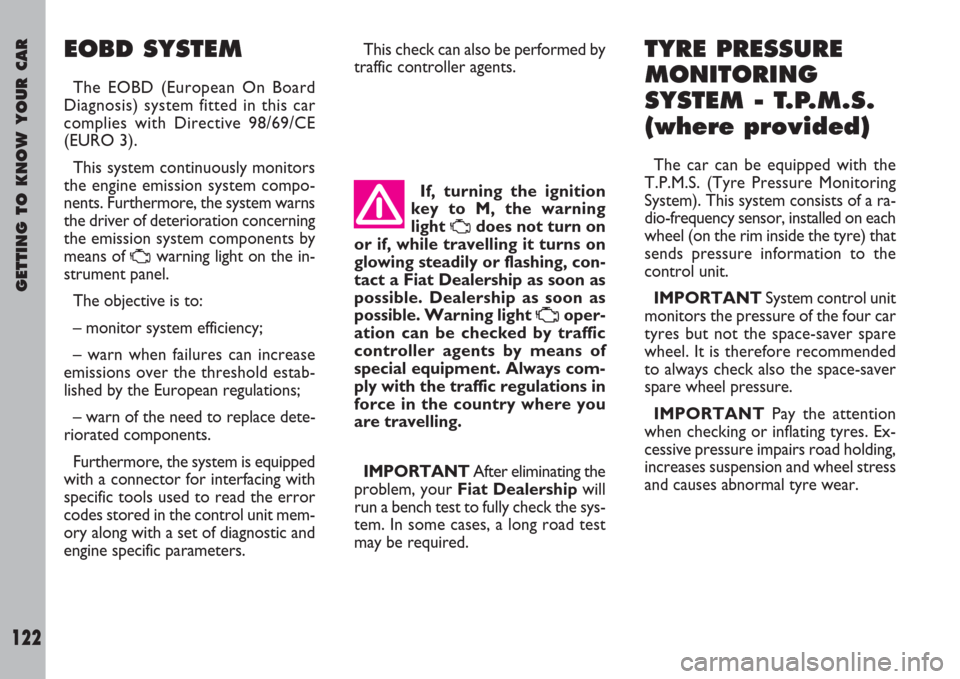
GETTING TO KNOW YOUR CAR
122
EOBD SYSTEM
The EOBD (European On Board
Diagnosis) system fitted in this car
complies with Directive 98/69/CE
(EURO 3).
This system continuously monitors
the engine emission system compo-
nents. Furthermore, the system warns
the driver of deterioration concerning
the emission system components by
means of
Uwarning light on the in-
strument panel.
The objective is to:
– monitor system efficiency;
– warn when failures can increase
emissions over the threshold estab-
lished by the European regulations;
– warn of the need to replace dete-
riorated components.
Furthermore, the system is equipped
with a connector for interfacing with
specific tools used to read the error
codes stored in the control unit mem-
ory along with a set of diagnostic and
engine specific parameters. This check can also be performed by
traffic controller agents.
If, turning the ignition
key to M, the warning
light
Udoes not turn on
or if, while travelling it turns on
glowing steadily or flashing, con-
tact a Fiat Dealership as soon as
possible. Dealership as soon as
possible. Warning light
Uoper-
ation can be checked by traffic
controller agents by means of
special equipment. Always com-
ply with the traffic regulations in
force in the country where you
are travelling.
IMPORTANTAfter eliminating the
problem, your Fiat Dealershipwill
run a bench test to fully check the sys-
tem. In some cases, a long road test
may be required.
TYRE PRESSURE
MONITORING
SYSTEM - T.P.M.S.
(where provided)
The car can be equipped with the
T.P.M.S. (Tyre Pressure Monitoring
System). This system consists of a ra-
dio-frequency sensor, installed on each
wheel (on the rim inside the tyre) that
sends pressure information to the
control unit.
IMPORTANTSystem control unit
monitors the pressure of the four car
tyres but not the space-saver spare
wheel. It is therefore recommended
to always check also the space-saver
spare wheel pressure.
IMPORTANTPay the attention
when checking or inflating tyres. Ex-
cessive pressure impairs road holding,
increases suspension and wheel stress
and causes abnormal tyre wear.
Page 124 of 254
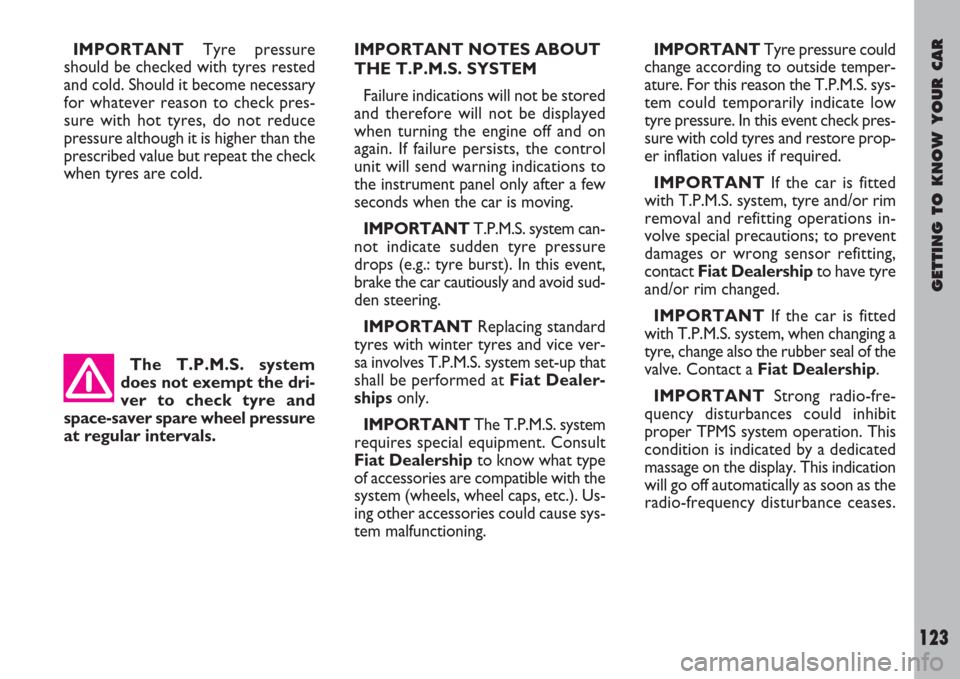
The T.P.M.S. system
does not exempt the dri-
ver to check tyre and
space-saver spare wheel pressure
at regular intervals.
GETTING TO KNOW YOUR CAR
123
IMPORTANTTyre pressure
should be checked with tyres rested
and cold. Should it become necessary
for whatever reason to check pres-
sure with hot tyres, do not reduce
pressure although it is higher than the
prescribed value but repeat the check
when tyres are cold.IMPORTANT NOTES ABOUT
THE T.P.M.S. SYSTEM
Failure indications will not be stored
and therefore will not be displayed
when turning the engine off and on
again. If failure persists, the control
unit will send warning indications to
the instrument panel only after a few
seconds when the car is moving.
IMPORTANTT.P.M.S. system can-
not indicate sudden tyre pressure
drops (e.g.: tyre burst). In this event,
brake the car cautiously and avoid sud-
den steering.
IMPORTANTReplacing standard
tyres with winter tyres and vice ver-
sa involves T.P.M.S. system set-up that
shall be performed at Fiat Dealer-
ships only.
IMPORTANT The T.P.M.S. system
requires special equipment. Consult
Fiat Dealership to know what type
of accessories are compatible with the
system (wheels, wheel caps, etc.). Us-
ing other accessories could cause sys-
tem malfunctioning.IMPORTANTTyre pressure could
change according to outside temper-
ature. For this reason the T.P.M.S. sys-
tem could temporarily indicate low
tyre pressure. In this event check pres-
sure with cold tyres and restore prop-
er inflation values if required.
IMPORTANTIf the car is fitted
with T.P.M.S. system, tyre and/or rim
removal and refitting operations in-
volve special precautions; to prevent
damages or wrong sensor refitting,
contact Fiat Dealership to have tyre
and/or rim changed.
IMPORTANTIf the car is fitted
with T.P.M.S. system, when changing a
tyre, change also the rubber seal of the
valve. Contact a Fiat Dealership.
IMPORTANT Strong radio-fre-
quency disturbances could inhibit
proper TPMS system operation. This
condition is indicated by a dedicated
massage on the display. This indication
will go off automatically as soon as the
radio-frequency disturbance ceases.
Page 126 of 254
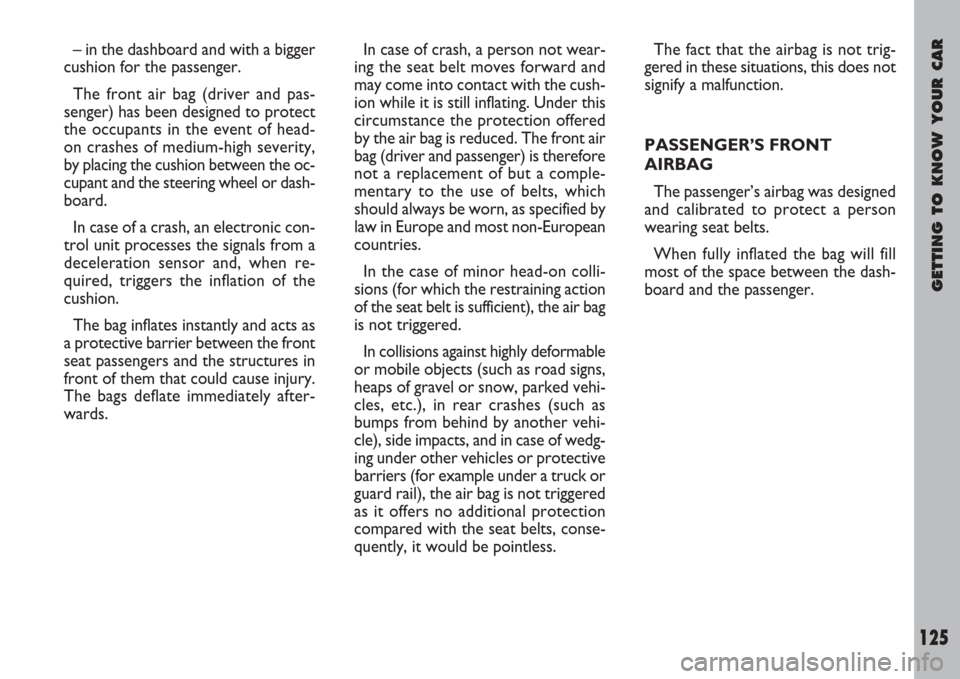
GETTING TO KNOW YOUR CAR
125
– in the dashboard and with a bigger
cushion for the passenger.
The front air bag (driver and pas-
senger) has been designed to protect
the occupants in the event of head-
on crashes of medium-high severity,
by placing the cushion between the oc-
cupant and the steering wheel or dash-
board.
In case of a crash, an electronic con-
trol unit processes the signals from a
deceleration sensor and, when re-
quired, triggers the inflation of the
cushion.
The bag inflates instantly and acts as
a protective barrier between the front
seat passengers and the structures in
front of them that could cause injury.
The bags deflate immediately after-
wards.In case of crash, a person not wear-
ing the seat belt moves forward and
may come into contact with the cush-
ion while it is still inflating. Under this
circumstance the protection offered
by the air bag is reduced. The front air
bag (driver and passenger) is therefore
not a replacement of but a comple-
mentary to the use of belts, which
should always be worn, as specified by
law in Europe and most non-European
countries.
In the case of minor head-on colli-
sions (for which the restraining action
of the seat belt is sufficient), the air bag
is not triggered.
In collisions against highly deformable
or mobile objects (such as road signs,
heaps of gravel or snow, parked vehi-
cles, etc.), in rear crashes (such as
bumps from behind by another vehi-
cle), side impacts, and in case of wedg-
ing under other vehicles or protective
barriers (for example under a truck or
guard rail), the air bag is not triggered
as it offers no additional protection
compared with the seat belts, conse-
quently, it would be pointless.The fact that the airbag is not trig-
gered in these situations, this does not
signify a malfunction.
PASSENGER’S FRONT
AIRBAG
The passenger’s airbag was designed
and calibrated to protect a person
wearing seat belts.
When fully inflated the bag will fill
most of the space between the dash-
board and the passenger.
Page 128 of 254
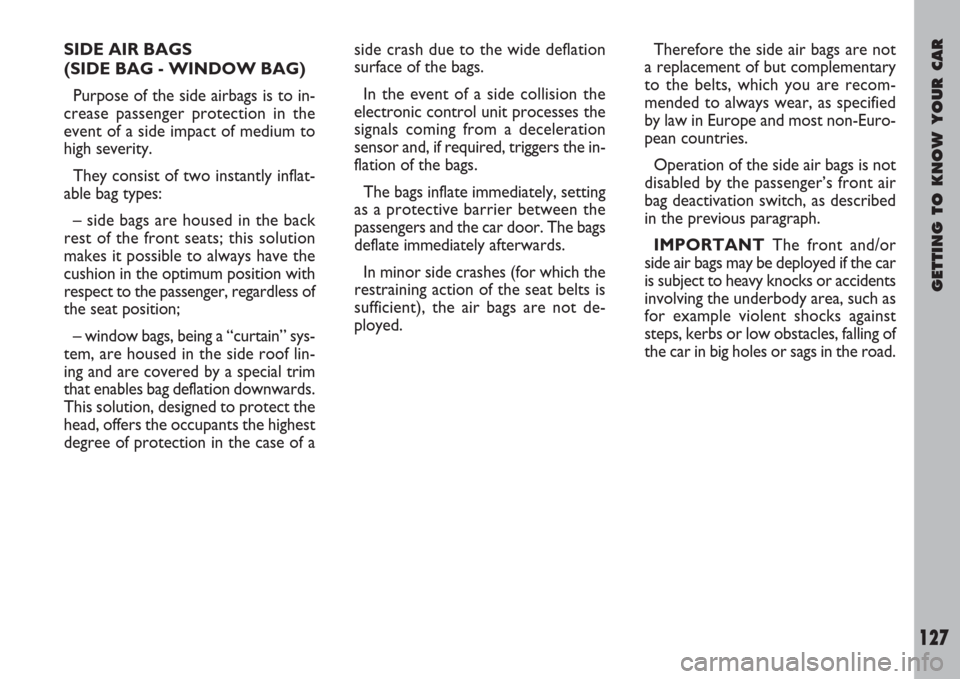
GETTING TO KNOW YOUR CAR
127
SIDE AIR BAGS
(SIDE BAG - WINDOW BAG)
Purpose of the side airbags is to in-
crease passenger protection in the
event of a side impact of medium to
high severity.
They consist of two instantly inflat-
able bag types:
– side bags are housed in the back
rest of the front seats; this solution
makes it possible to always have the
cushion in the optimum position with
respect to the passenger, regardless of
the seat position;
– window bags, being a “curtain” sys-
tem, are housed in the side roof lin-
ing and are covered by a special trim
that enables bag deflation downwards.
This solution, designed to protect the
head, offers the occupants the highest
degree of protection in the case of aside crash due to the wide deflation
surface of the bags.
In the event of a side collision the
electronic control unit processes the
signals coming from a deceleration
sensor and, if required, triggers the in-
flation of the bags.
The bags inflate immediately, setting
as a protective barrier between the
passengers and the car door. The bags
deflate immediately afterwards.
In minor side crashes (for which the
restraining action of the seat belts is
sufficient), the air bags are not de-
ployed.Therefore the side air bags are not
a replacement of but complementary
to the belts, which you are recom-
mended to always wear, as specified
by law in Europe and most non-Euro-
pean countries.
Operation of the side air bags is not
disabled by the passenger’s front air
bag deactivation switch, as described
in the previous paragraph.
IMPORTANTThe front and/or
side air bags may be deployed if the car
is subject to heavy knocks or accidents
involving the underbody area, such as
for example violent shocks against
steps, kerbs or low obstacles, falling of
the car in big holes or sags in the road.
Page 131 of 254
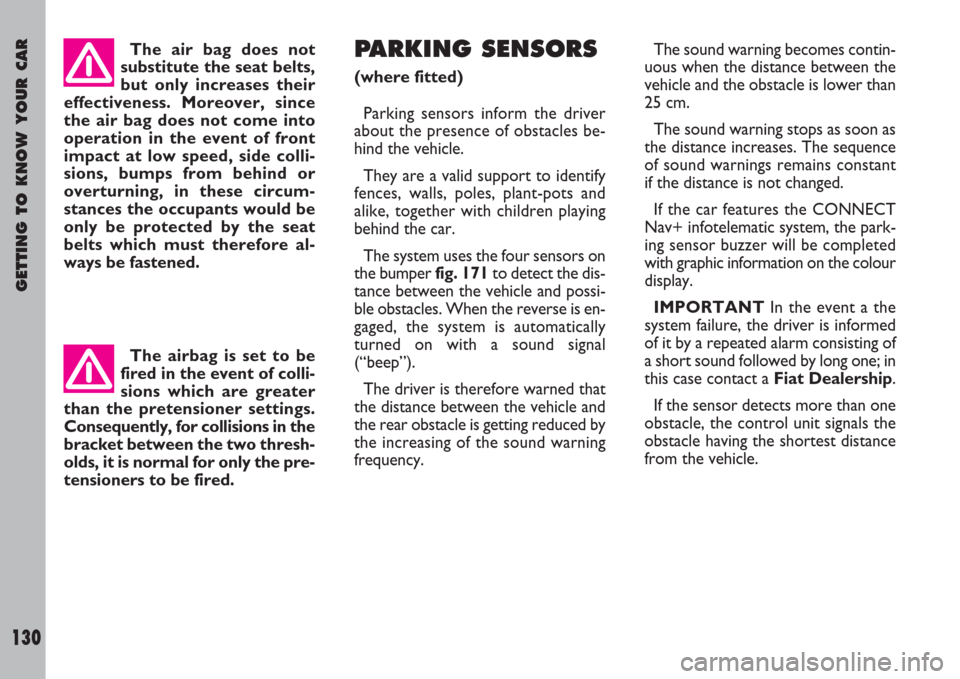
GETTING TO KNOW YOUR CAR
130
PARKING SENSORS
(where fitted)
Parking sensors inform the driver
about the presence of obstacles be-
hind the vehicle.
They are a valid support to identify
fences, walls, poles, plant-pots and
alike, together with children playing
behind the car.
The system uses the four sensors on
the bumper fig. 171to detect the dis-
tance between the vehicle and possi-
ble obstacles. When the reverse is en-
gaged, the system is automatically
turned on with a sound signal
(“beep”).
The driver is therefore warned that
the distance between the vehicle and
the rear obstacle is getting reduced by
the increasing of the sound warning
frequency.The sound warning becomes contin-
uous when the distance between the
vehicle and the obstacle is lower than
25 cm.
The sound warning stops as soon as
the distance increases. The sequence
of sound warnings remains constant
if the distance is not changed.
If the car features the CONNECT
Nav+ infotelematic system, the park-
ing sensor buzzer will be completed
with graphic information on the colour
display.
IMPORTANTIn the event a the
system failure, the driver is informed
of it by a repeated alarm consisting of
a short sound followed by long one; in
this case contact aFiat Dealership.
If the sensor detects more than one
obstacle, the control unit signals the
obstacle having the shortest distance
from the vehicle. The airbag is set to be
fired in the event of colli-
sions which are greater
than the pretensioner settings.
Consequently, for collisions in the
bracket between the two thresh-
olds, it is normal for only the pre-
tensioners to be fired.
The air bag does not
substitute the seat belts,
but only increases their
effectiveness. Moreover, since
the air bag does not come into
operation in the event of front
impact at low speed, side colli-
sions, bumps from behind or
overturning, in these circum-
stances the occupants would be
only be protected by the seat
belts which must therefore al-
ways be fastened.
Page 132 of 254
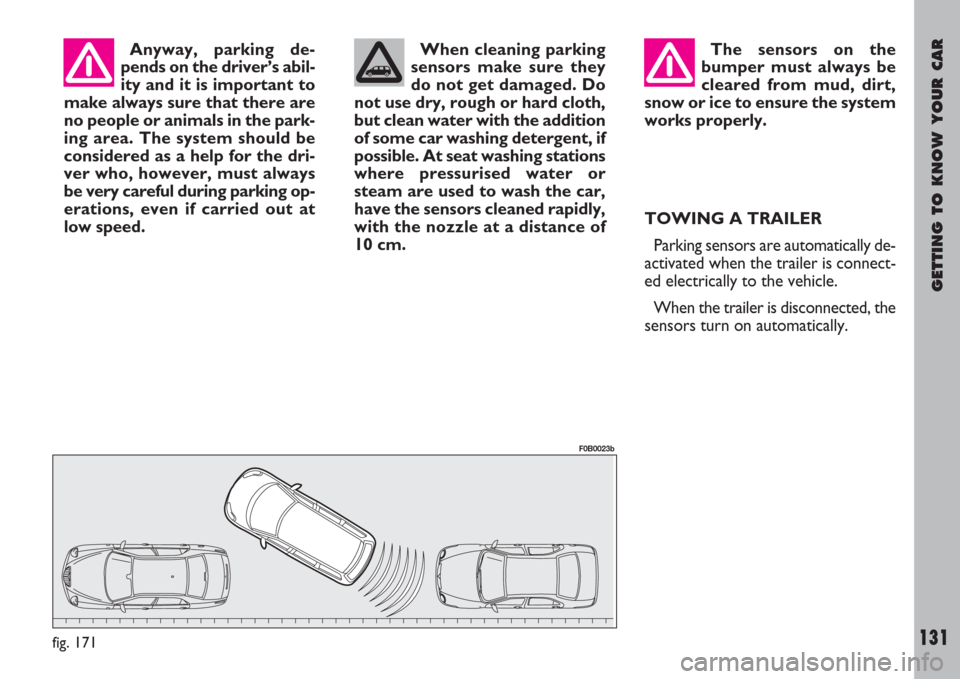
GETTING TO KNOW YOUR CAR
131
When cleaning parking
sensors make sure they
do not get damaged. Do
not use dry, rough or hard cloth,
but clean water with the addition
of some car washing detergent, if
possible. At seat washing stations
where pressurised water or
steam are used to wash the car,
have the sensors cleaned rapidly,
with the nozzle at a distance of
10 cm.TOWING A TRAILER
Parking sensors are automatically de-
activated when the trailer is connect-
ed electrically to the vehicle.
When the trailer is disconnected, the
sensors turn on automatically. Anyway, parking de-
pends on the driver’s abil-
ity and it is important to
make always sure that there are
no people or animals in the park-
ing area. The system should be
considered as a help for the dri-
ver who, however, must always
be very careful during parking op-
erations, even if carried out at
low speed.The sensors on the
bumper must always be
cleared from mud, dirt,
snow or ice to ensure the system
works properly.
fig. 171
F0B0023b
Page 133 of 254
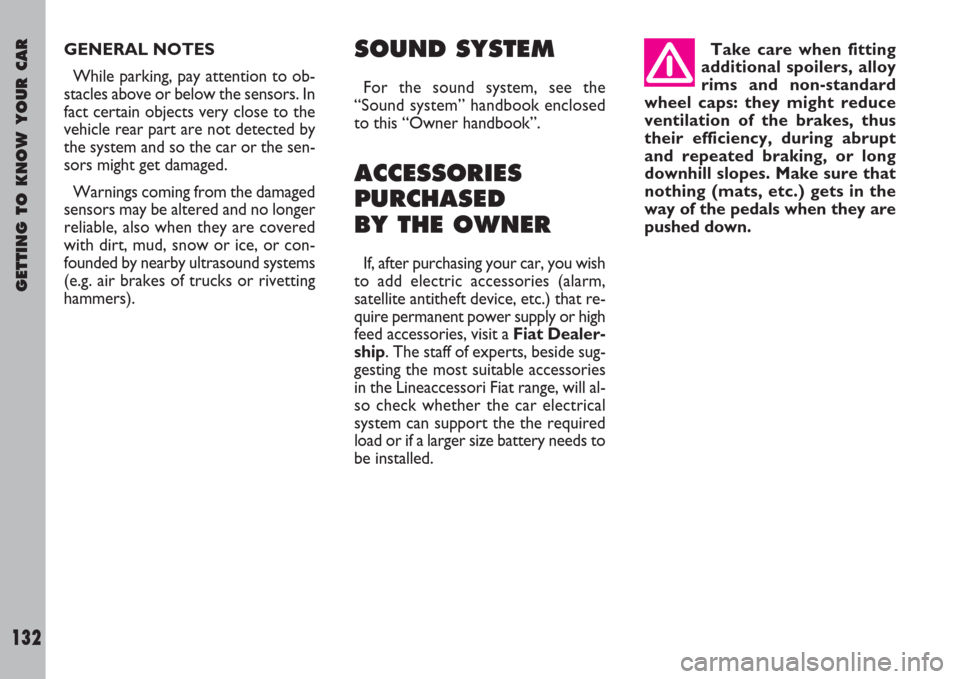
GETTING TO KNOW YOUR CAR
132
GENERAL NOTES
While parking, pay attention to ob-
stacles above or below the sensors. In
fact certain objects very close to the
vehicle rear part are not detected by
the system and so the car or the sen-
sors might get damaged.
Warnings coming from the damaged
sensors may be altered and no longer
reliable, also when they are covered
with dirt, mud, snow or ice, or con-
founded by nearby ultrasound systems
(e.g. air brakes of trucks or rivetting
hammers).SOUND SYSTEM
For the sound system, see the
“Sound system” handbook enclosed
to this “Owner handbook”.
ACCESSORIES
PURCHASED
BY THE OWNER
If, after purchasing your car, you wish
to add electric accessories (alarm,
satellite antitheft device, etc.) that re-
quire permanent power supply or high
feed accessories, visit a Fiat Dealer-
ship. The staff of experts, beside sug-
gesting the most suitable accessories
in the Lineaccessori Fiat range, will al-
so check whether the car electrical
system can support the the required
load or if a larger size battery needs to
be installed.Take care when fitting
additional spoilers, alloy
rims and non-standard
wheel caps: they might reduce
ventilation of the brakes, thus
their efficiency, during abrupt
and repeated braking, or long
downhill slopes. Make sure that
nothing (mats, etc.) gets in the
way of the pedals when they are
pushed down.
Page 149 of 254
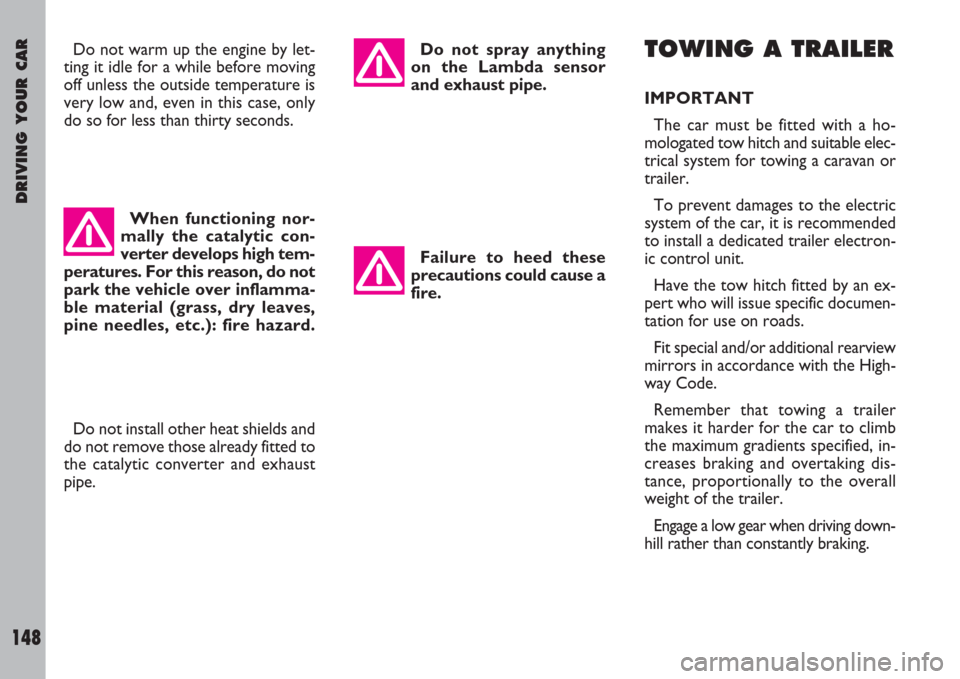
DRIVING YOUR CAR
148
Do not warm up the engine by let-
ting it idle for a while before moving
off unless the outside temperature is
very low and, even in this case, only
do so for less than thirty seconds.
Do not install other heat shields and
do not remove those already fitted to
the catalytic converter and exhaust
pipe.Do not spray anything
on the Lambda sensor
and exhaust pipe.TOWING A TRAILER
IMPORTANT
The car must be fitted with a ho-
mologated tow hitch and suitable elec-
trical system for towing a caravan or
trailer.
To prevent damages to the electric
system of the car, it is recommended
to install a dedicated trailer electron-
ic control unit.
Have the tow hitch fitted by an ex-
pert who will issue specific documen-
tation for use on roads.
Fit special and/or additional rearview
mirrors in accordance with the High-
way Code.
Remember that towing a trailer
makes it harder for the car to climb
the maximum gradients specified, in-
creases braking and overtaking dis-
tance, proportionally to the overall
weight of the trailer.
Engage a low gear when driving down-
hill rather than constantly braking. When functioning nor-
mally the catalytic con-
verter develops high tem-
peratures. For this reason, do not
park the vehicle over inflamma-
ble material (grass, dry leaves,
pine needles, etc.): fire hazard.Failure to heed these
precautions could cause a
fire.